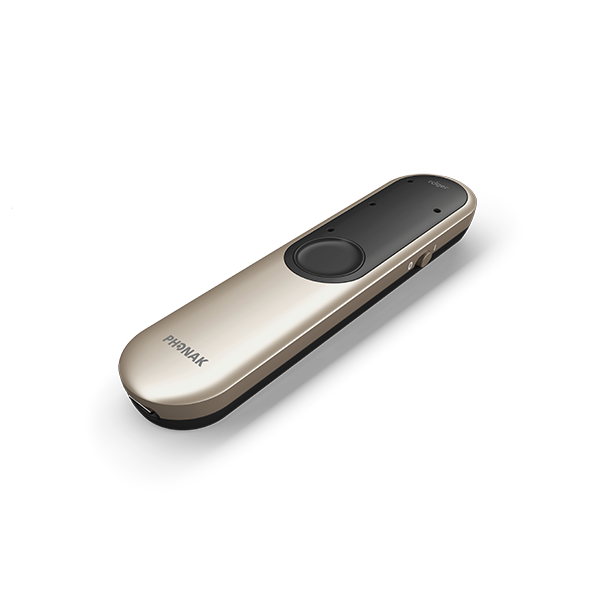Roger On™: A Microphone Dedicated for all Conversations
AudiologyOnline: What makes Roger On™ different from the Roger Pen?

Bill Bielski, AuD: With Roger On, Pointing mode has been improved. Pointing mode 2.0 uses three microphones in a row, instead of two, as in the Roger Pen™. The three microphones create different microphone beams that combine to create a very well-defined, zooming beamformer, allowing the patient to focus on one person talking or in a group conversation when background noise is present.
In addition, MultiBeam mode has also been improved from prior Roger™ microphones (Roger Table Mic II and Roger Select™). MultiBeam 2.0 technology selects the beam with the best SNR, while giving the hearing aid wearer spatial information to determine from which direction the speech is coming from. Roger On is the first Roger microphone that allows for stereo sound. It will switch to stereo sound transmission when a stereo capable receiver, such as a set of two hearing aids with RogerDirect, is paired to Roger On.
Finally, Roger On has connectivity to the new myRogerMic application. Within your app you can have incredible control over your Roger On microphone, such as steering of microphone beam, changing microphone modes, mute and unmute, microphone status, battery status, custom modes and more! (The app will be available for download on July 1.)
AudiologyOnline: What other microphones can pair with the Roger On?
Bill Bielski, AuD: Roger On is compatible with all other Roger for adult microphones and receivers.
AudiologyOnline: What types of patients benefit from Roger technology?
Bill Bielski, AuD: Market Track 9 indicates 31% of hearing aid wearers still experience difficulties in background noise1! Noise and distance are the where Roger microphones thrive – and indeed these situations are commonplace in our modern society. Individuals of most every age and hearing loss configurations can benefit from Roger technology. In fact, even individuals with APD or on the ASD can also find great results. Additionally, a review of Target data suggests 60% of Roger users have a mild to moderate hearing loss2.
AudiologyOnline: Roger is used in schools, but can it also help working adults?
Bill Bielski, AuD: Absolutely! Like the classroom, the modern workplace is inherently filled with noise and distance to the speaker of interest. Roger microphones are an ideal solution to bridge the communication gap that difficult scenarios like the workplace present. Whether it’s a group meeting, video chat, presentation or a just a stroll outside with a coworker – Roger keeps you connected to the conversation.

AudiologyOnline: Do you have a recommended way of doing an in-clinic demo?
Bill Bielski, AuD: Phonak has put together a step-by-step guide for an in-office Roger demonstration – this makes up the backbone of my process, and could very easily be tailored to fit your office preferences.
For a new or seasoned Roger office, this is a great tool to have on-hand to aid your Roger demonstrations. Speak to your Phonak representative to secure a copy!
AudiologyOnline: How do I help a patient chose the right microphone?
Bill Bielski, AuD: The Roger EasyGuide is the only tool that I use to choose microphone set-ups. The Roger EasyGuide allows you to rank order the situations you are struggling in at work, home and social life, and provides results that speak to the best microphone set-up, along with descriptions of the recommended microphones themselves. This can be easily printed or emailed to bring along to share with a family member or human resources in the case of reasonable accommodations.
AudiologyOnline: Is funding available for Roger?
Bill Bielski, AuD: Yes! For employees in companies of 15 or more, with documented hearing loss – Reasonable Accommodation is likely a path to Roger funding.
AudiologyOnline: What is Reasonable Accommodation – and what supports its use?
Bill Bielski, AuD: A reasonable accommodation is any change to the application or hiring process, to the job, to the way the job is done, or the work environment that allows a person with a disability who is qualified for the job to perform the essential functions of that job and enjoy equal employment opportunities. Accommodations are considered “reasonable” if they do not create an undue hardship or a direct threat to a company.
Reasonable Accommodation is supported by the Americans with Disabilities Act of 1990 (ADA). The ADA is a civil rights law that prohibits discrimination based on disability. Federal employees also protected by Rehabilitation Act of 1973.
AudiologyOnline: Who is eligible for RA & how do you apply?
Bill Bielski, AuD: The Americans with Disabilities Act defines an individual of “disability” that would qualify them for reasonable accommodations if they have “a physical or mental impairment that substantially limits one or more major life activities.”
Documented hearing loss would qualify an individual for RA. Under the ADA, employers who have 15 or more employees are usually required to provide reasonable accommodations. Some state and local laws may require that employers with fewer employees provide reasonable accommodations.
AudiologyOnline: How do you apply for RA?
Bill Bielski, AuD: The first step in the reasonable accommodation process is disclosure of a disability, as employers are only required to accommodate disabilities of which they are aware. It is important to note that the process must be interactive, with participation by both the person with a disability and the employer, and in our case the HCP as well, so that an effective solution may be agreed upon.
AudiologyOnline: Where can I find out more about RA?
Bill Bielski, AuD: Reasonable Accommodation for working employees can be explained by your Phonak account representative.
Additionally, more information on Reasonable Accommodation can be found at: us.morethanahearingaid.com/ada, www.ada.com, and www.askjan.com
For more information about Roger On microphone technology, click here.
- Abrams, H. B., & Kihm, J. (2015). An Introduction to MarkeTrak IX: A New Baseline for the Hearing Aid Market. Hearing Review, 22(6), 16.
- Senn. M., Baney, L. (2018). An analysis of programs Roger Pen distribution across hearing loss – Phonak Target Fitting Data. Unpublished data.


